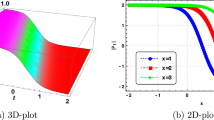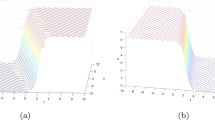Abstract
We give an exhaustive, non-perturbative classification of exact travelling-wave solutions of a perturbed sine-Gordon equation (on the real line or on the circle) which is used to describe the Josephson effect in the theory of superconductors and other remarkable physical phenomena. The perturbation of the equation consists of a constant forcing term and a linear dissipative term. On the real line candidate orbitally stable solutions with bounded energy density are either the constant one, or of kink (i.e. soliton) type, or of array-of-kinks type, or of “half-array-of-kinks” type. While the first three have unperturbed analogs, the last type is essentially new. We also propose a convergent method of successive approximations of the (anti)kink solution based on a careful application of the fixed point theorem.




Similar content being viewed by others
Notes
For instance, by Proposition 3 if \(\epsilon =-\) and \(z(g)\) is defined at least in an interval of length \(2\pi \) then \(g_+=\infty , z(g)\) diverges as \(g\rightarrow \infty , g'(\xi ),\varphi _x,\varphi _t\) diverge as \(\xi \rightarrow -\infty \).
In Ref. [10] this was shown only for \(\gamma <1\). Actually the arguments used there apply also for \(\gamma \ge 1.\)
In fact, if \(u(\xi )>0\) consider the \(\check{p}(\xi )\) with argument \(\xi \) shifted the right amount in order that it attracts \(p(\xi )\) as \(\xi \rightarrow \infty \). If \(u(\xi )>\check{u}(\xi )\), by Property 3 \(u(\xi )\rightarrow \infty \) as \(\xi \rightarrow -\infty \); if \(u(\xi )<\check{u}(\xi )\) then \(p(\xi )\) either is a saddle connection \(\bar{p}_k(\xi )\), or its \(u(\xi )\) becomes negative for sufficiently early ’times’ \(\xi \), and again by Property 3 \(u(\xi )\rightarrow -\infty \) as \(\xi \rightarrow -\infty \). The latter situation occurs also to the \(p(\xi )\) with negative \(u(\xi )\) for sufficiently early ‘times’ \(\xi \) and ending on some \(A_k,B_k\), or \(C_k\).
Our \(v,X(v)\) are resp. denoted as \(c,L(c)\) in [27]. Incidentally, the velocities \(c_1<1, c_2>1\) of the slow and fast solitary waves considered there are in fact the two solutions \(v_1,v_2\) of (11) seen as an equation in the unknown \(|v|\) when \(\mu =\hat{\mu }(\gamma )\); as a consequence they fulfill the relation \(v_1^{-2}+v_2^{-2}=2\), not noted in [27].
If ad absurdum \(\sup |z/p^2|=\infty \) then the lhs would certainly exceed \(\varepsilon \).
Here we recall the latter in the restricted version: if f fulfills conditions ensuring that the differential problem \(\tilde{u}'=f(x,\tilde{u}), \tilde{u}(x_0)=u(x_0)\), has a unique solution \(\tilde{u}\), and \(u'< f(x,u)\) for all \(x\), then it is \(u(x)<\tilde{u}(x)\) for all \(x>x_0\) and \(u(x)>\tilde{u}(x)\) for all \(x<x_0\).
References
Amerio L (1949) Determinazione delle condizioni di stabilitá per gli integrali di un’equazione interessante in elettrotecnica. Ann Mat 30:75–90
Andronov AA, Chaikin CE (1949) Theory of oscillations. Princeton University Press, Princeton
Barone A, Esposito F, Magee CJ, Scott AC (1971) Theory and applications of the sine-Gordon equation. Riv Nuovo Cimento 1:227
Barone A, Paternó G (1982) Physics and applications of the Josephson effect. Wiley-Interscience, New York; and references therein
Christiansen PL, Scott AC, Sorensen MP (2000) Nonlinear science at the dawn of the 21st century, lecture notes in physics, vol 542. Springer, Berlin
D’Acunto B, Renno P (1992) On some nonlinear visco-elastic models. Ric Mat 41:101–122
D’Anna A, Fiore G (2005) Global stability properties for a class of dissipative phenomena via one or several Liapunov functionals. Nonlinear Dyn Syst Theory 5:9–38
D’Anna A, Fiore G (2009) Stability properties for some non-autonomous dissipative phenomena proved by families of Liapunov functionals. Nonlinear Dyn Syst Theory 9:249–262
D’Anna A, Fiore G (2013) Existence, uniqueness and stability for a class of third-order dissipative problems depending on time. Nonlinear Anal Theory Methods Appl 78:104–120
D’Anna A, De Angelis M, Fiore G (2005) Towards soliton solutions of a perturbed sine-Gordon equation. Rend Acc Sci Fis Mat Napoli LXXII, pp 95–110. math-ph/0507005
De Angelis M, Renno P (2008) Existence, uniqueness and a priori estimates for a non linear integro-differential equation. Ric Mat 57:95–109
De Angelis M, Fiore G (2013) Existence and uniqueness of solutions of a class of third order dissipative problems with various boundary conditions describing the Josephson effect. J Math Anal Appl 404:477–490
De Angelis M, Fiore G (2014) Diffusion effects on a superconductive model. Commun Pure Appl Anal 13:217–223
Derks G, Doelman A, van Gils SA, Visser T (2003) Travelling waves in a singularly perturbed sine-Gordon equation. Phys D 180:40–70
Fiore G (2008) Some explicit travelling-wave solutions of a perturbed sine-Gordon equation. In: Liguori (ed) Mathematical physics models and engineering sciences, Napoli, pp 281–288. math-ph/0507005
Fogel MB, Trullinger SE, Bishop AR, Krumhansl JA (1976) Classical particle like behavior of sine-Gordon solitons in scattering potentials and applied fields. Phys Rev Lett 36:1411–1414
Fogel MB, Trullinger SE, Bishop AR, Krumhansl JA (1977) Dynamics of sine-Gordon solitons in the presence of perturbations. Phys Rev B 15:1578–1592
Hayes WD (1953) On the equation for a damped pendulum under a constant torque. Z Angew Math Phys 4:398–401
Johnson WJ (1968) Nonlinear wave propagation on superconducting tunneling junctions. Ph.D. Thesis, University of Wisconsin
Jones CKRT, Marangell R, Miller PD, Plaza RG (2013) On the stability analysis of periodic sine-Gordon traveling waves. Phys D 251:63–74
Josephson BD (1962) Possible new effects in superconductive tunneling. Phys Lett 1:251–253
Josephson BD (1974) The discovery of tunnelling supercurrents. Rev Mod Phys B 46:251–254
Kaup DJ (1976) A perturbation expansion from the Zakharov–Shabat inverse scattering transform. SIAM J Appl Math 31:121–133
Kaup DJ (1976) Closure of the squared Zakharov–Shabat eigenstates. J Math Anal Appl 54:849–864
Kaup DJ, Newell AC (1978) Solitons as particles and oscillators, and in slowly changing media: a singular perturbation theory. Proc R Soc Lond Ser A 361:413–446
Levi M, Hoppensteadt FC, Miranker WL (1978) Dynamics of the Josephson junction. Q Appl Math 35:167
Maginu K (1980) Stability of travelling wave solutions of the active Josephson junction transmission line. J Differ Equ 37:238–260
McLaughlin DW, Scott AC (1977) Fluxon interactions. Appl Phys Lett 30:545–547
McLaughlin DW, Scott AC (1978) Perturbation analysis in fluxon dynamics. Phys Rev A 18:1652–1680
Nakajima K, Onodera Y, Nakamura T, Sato R (1974) Numerical analysis of vortex motion in Josephson structure. J Appl Phys 45:4095
Newell AC (1978) The inverse scattering transform, nonlinear waves, singular perturbations and synchronized solitons. Rocky Mt J Math 8:25
Rionero S (2012) Asymptotic behaviour of solutions to a nonlinear third order P.D.E. modeling physical phenomena. Boll Unione Mat Ital 9:451–468
Sansone G, Conti R (1956) Equazioni differenziali nonlineari, CNR—Monografie Matematiche 3. Ed. Cremonese, Roma
Satsuma J, Yajima N (1974) Initial value problems of one-dimensional self-modulation of nonlinear waves in dispersive media. Prog Theor Phys Suppl 55:284–295
Scott AC (1969) Waveform stability of a nonlinear Klein–Gordon equation. Proc IEEE 57:1338
Scott AC (1970) Active and nonlinear wave propagation in electronics (chap 2, 5). Wiley-Interscience, New York
Shohet JL, Barmish BR, Ebraheem HK, Scott AC (2004) The sine-Gordon equation in reversed-field pinch experiments. Phys Plasmas 11:3877
Strogatz SH (1994) Nonlinear dynamics and chaos. Westview (Perseus Publishing Group), Reading, MA
Tricomi F (1931) Sur une équation differentielle de l’electrotechnique. C-R Acad Sci Paris 198:635
Tricomi F (1933) Integrazione di un’equation differenziale presentatasi in elettrotecnica. Ann Sc Norm Sup Pisa 2:1–20
Urabe M (1954) The least upper bound of a damping coefficient ensuring the existence of a periodic motion of a pendulum under a constant torque. J Sci Hiroshima Univ Ser A 18:379–389
Yoshizawa T (1966) Stability theory by Liapunov’s second method. The Mathematical Society, Japan
Acknowledgments
We are grateful to C. Nappi for information on the present state-of-the-art of research on the Josephson effect and for useful discussions. It is also a pleasure to thank Prof. A. D’Anna and P. Renno for their encouragement and stimulating observations. This research was partially supported by UniNA and Compagnia di San Paolo under the grant “STAR Program 2013”.
Author information
Authors and Affiliations
Corresponding author
Appendix
Appendix
Proof of Proposition 1
Let \(0\le z_{0,2}<z_{0,1}, z_j(g):=z(g;g_0,z_{0,j};\mu ,\gamma )\) (\(j=1,2\)) be the corresponding solutions of (15) and \(G_j\) the corresponding intervals giving their (maximal) domains. By continuity the inequality
will hold in a neighbourhood of \(g_0\) within \(G_1\cap G_2\). In fact, it will hold for all \(g\in G_1\cap G_2\). If ad absurdum this were not the case, denote by \(\bar{g}\in G_1\cap G_2\) the least \(g>g_0\) (resp. largest \(g<g_0\)) where \(z_1-z_2\) vanishes: \(z_1(\bar{g})-z_2(\bar{g})=0\); then the problem (15) with initial (resp. final) condition \(z(\bar{g})=z_1(\bar{g})\equiv z_2(\bar{g})\) would admit the two different solutions \(z_1, z_2\), against the existence and uniqueness theorem. As for the monotonicity of \(g_{\pm }\), by the same theorem \(z_1(g_{2\pm })>z_2(g_{2\pm })=0\) implies \(g_{1+}>g_{2+}\) if \(g_{2+}<\infty \), otherwise \(g_{1+}=g_{2+}=\infty \), and \(g_{1-}<g_{2-}\) if \(g_{2-}>-\infty \), otherwise \(g_{1-}=g_{2-}=-\infty \). \(\square \)
Proof of Proposition 2
Let \(\mu _1\le \mu _2, \gamma _1\epsilon \ge \gamma _2\epsilon \), with one of the two inequalities being strict; for \(j=1,2\) let \(u_j(g):=u(g;g_0,u_0;\mu _j,\gamma )\) be the corresponding solutions of (15) with the same condition \(u_j(g_0) =u_0\), and \(G_j\) the intervals giving their (maximal) domains. We find
By the comparison principleFootnote 6 (see e.g. [42]) it follows, as claimed,
If \(\epsilon >0\), this implies: \(\lim _{g\downarrow g_{2+}}u_1(g)\ge \lim _{g\downarrow g_{2+}}u_2(g)=0\) and therefore \(g_{1+}\ge g_{2+}\) (the inequalities being strict as long as \(g_{2+}<\infty \)); \(\lim _{g\uparrow g_{1-}}u_2\ge 0\) and therefore \(g_{1,-}\ge g_{2-}\) (the inequalities being strict as long as \(g_{1-}>-\infty \)). Moreover, let \(g_j(\xi )=g(\xi ;g_0,u_0;\mu _j,\gamma _j)\) be the corresponding two solutions of (16), i.e. the solutions of (10). We find
while \(g_2(\xi _0)=g_0=g_1(\xi _0)\). By the comparison principle this implies as claimed \(g_2(\xi )<g_1(\xi )\) for all \(\xi \in X_1\cap X_2\). Similarly one argues if \(\epsilon <0\). \(\square \)
Proof of Proposition 3
Consider the Cauchy problem (15) in subsequent intervals \(]g_k,g_{k+1}[ \subset G\). Since the equation is invariant under \(g\rightarrow g+2\pi \), by Proposition 1 if \(z(g_1)\) is respectively larger, equal, smaller than \(z(g_0)\) then so are \(z(g_{k+1}),I_{k+1}\) in comparison with \(z(g_k),I_k\) respectively, for all \(k\in K\); in other words, the sequences \(\{z(g_k)\}, \{I_k\}\) are either constant, or strictly monotonic. Equation (21) follows from (19) applied in \(]g_k,g_{k+1}[\).
If \(\epsilon =-\), then rhs (21)\(>2\pi \gamma >0\) for any k, so that the sequences are strictly increasing and diverging as \(k\rightarrow \infty \), whereas K must have a lower bound, otherwise \(z(g_k)\) would become negative for sufficiently low k.
If \(\epsilon =+\), then the two terms at the rhs (21) have opposite sign and can compensate each other. If the sequences are strictly increasing, the sides of (21) are positive for all k and \(I_k<2\pi \gamma /\mu \). Applying (19) to the interval \([g_k,g_k+\Delta g]\) for any \(\Delta g\le 2\pi \) we find
But \(|U(g_k)-U(g_k+\Delta g)|\) is upper bounded, e.g. by \(2+2\pi \gamma \), whence
If ad absurdum \(z(g_k)\) diverged as \(k\rightarrow \infty \), then also \(z(g_k+\Delta g)\) and in turn \(I_k\) [by (20)] would diverge, in contrast with \(I_k<2\pi \gamma /\mu \); so it must converge. Moreover, as before, K must have a lower bound. On the other hand, rewriting (21) in the form \(z(g_{k-1})-z(g_k)=\mu I_{k-1}-2\pi \gamma \), we see that if the sequences \(\{z(g_k)\},\{I_k\}\) are strictly decreasing, the sides are positive for all k and larger than \( \mu I_0-2\pi \gamma >0\) for all negative k; this implies that they diverge as \(k\rightarrow -\infty \), and again by (67) so do \(z(g),I(z,g)\). Whereas they must either converge as \(k\rightarrow \infty \), or K must have an upper bound. \(\square \)
Rights and permissions
About this article
Cite this article
Fiore, G., Guerriero, G., Maio, A. et al. On kinks and other travelling-wave solutions of a modified sine-Gordon equation. Meccanica 50, 1989–2006 (2015). https://doi.org/10.1007/s11012-015-0143-y
Received:
Accepted:
Published:
Issue Date:
DOI: https://doi.org/10.1007/s11012-015-0143-y




